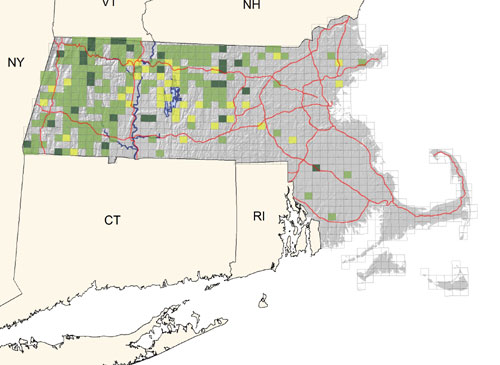Breeding Bird Atlases (BBA)
Find a Bird - BBA1
Breeding Bird Atlas 1 Species Accounts
Blue-headed Vireo
Vireo solitarius
Egg Dates
May 13 to July 29
Number of Broods
one, sometimes two

The Blue-headed Vireo, once known as the Solitary Vireo, is a fairly common summer resident of the high ground country of northern Worcester County westward throughout all of Franklin and Berkshire counties. In Hampshire and Hampden counties, it nests mostly on the Berkshire escarpment, more sparingly on the eastern side of the Connecticut River valley, and onward through southern Worcester County. Nesting is extremely rare in eastern Massachusetts, except for northernmost Middlesex County, where it probably nests regularly. The species was unreported in the Atlas period for Suffolk, Barnstable, Nantucket, and Dukes counties and occurred in only one block each in Norfolk and Plymouth counties. Blue-headed Vireos nested more commonly in southeastern Massachusetts prior to 1938, when a hurricane destroyed many mature stands of White Pines.
In the leafless April woods, sometimes when there is still snow on the ground, the song of the first solitary can be heard. Spring arrival occurs in mid-April in company with the Ruby-crowned Kinglet and Pine, Palm, and Yellow-rumped warblers, with widespread arrival by the month’s end. Migration is protracted, and migrants appear throughout the state until mid-May.
The Blue-headed Vireo, described by many writers as a woodland recluse, dwells throughout the summer in cool, shady retreats in the solitude of the forests. It nests in coniferous or mixed woods with mature stands of White Pine or Eastern Hemlock invariably present. It is sometimes found in beech-hemlock woods. Interspersion of small openings with sapling hardwoods, blueberry, laurel, and other dense undergrowth is essential. Selective timber cuts sometimes create such openings, thereby benefiting the species.
Males seem to establish ill-defined territories of unknown size but that are out of hearing range of other pairs. Within these areas, singing birds wander about with no apparent singing tree, all the time deliberately gleaning insects among the foliage. The basic song is a series of rich, clear, two- to six-note phrases such as chu-wee-cheerio. Characteristically, any or all of these notes may be slurred. During courtship, numerous varied phrases are sometimes strung together and delivered rapidly in what is described as a rich warble. There are other contact and alarm calls, one of the latter being a harsh chatter.
Courting males, yellowish flank feathers fluffed out, are said to bob and bow before the female. Copulation may take place anywhere in the territory, often in low understory. Both sexes are involved in nest building, though the male’s role may be limited to fetching materials. Always near White Pine or Eastern Hemlock, the nest may be situated in understory sapling hardwoods or the low branches of a deciduous tree; sometimes it is actually built in one of the evergreens. Nests from eastern Massachusetts have been found in White Pine, Red Cedar, Eastern Hemlock, and saplings of oak, Gray Birch, American Beech, hickory, and walnut. Heights ranged from 3.5 to 20 feet (ACB). The pendant nests are usually placed in the fork of a horizontal branch. The nest cup is fashioned from shreds of tissue paper, bark and leaves, bits of lichen, and moss, and is lined with fine grasses, hairs, and small pine needles.
Clutches of three to five (usually four) eggs are laid. Clutch sizes for 11 state nests were two eggs (1 nest), three eggs (3 nests), four eggs (6 nests), five eggs (1 nest) (DKW). Incubation commences upon completion of the clutch and lasts from 11 to 14 days. Both sexes incubate and are reportedly tame and fearless at this time, even allowing themselves to be stroked or lifted up in the hand.
This species is frequently parasitized by the Brown-headed Cowbird. The female will cover a cowbird egg with a new nest floor if she has not completed her clutch. Nestlings are altricial. Both sexes are involved in the feeding and brooding of the young. The age at which fledging occurs is unreported but is probably 10 to 12 days as in the Red-eyed Vireo. Adults in Worcester County were observed carrying food, presumably to nestlings, from mid-June to early July. The late date for dependent young was September 2—a pair with three small fledglings in Spencer (Meservey). It is not known to what extent this species is double brooded in Massachusetts, but the late egg dates and the above fledgling date are good indications that this sometimes occurs.
Little to nothing is known about immediate postfledging events. After the nesting period, local Blue-headed Vireos become difficult to find. However, they are ordinarily in company with the first waves of northern warblers to reach us in late August and early September, and may, in fact, be some of the local birds that have joined the assemblages of migrant warblers. Migrating Blue-headed Vireos from farther north arrive in mid-September and continue into mid-October. The birds winter in the southern United States and south into Central America to Nicaragua and Guatemala.

Note: fairly common in mixed woodlands of central and western regions; rare in eastern sections
Bradford G. Blodget



